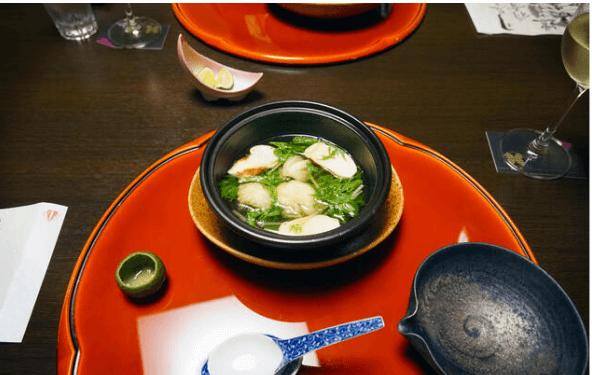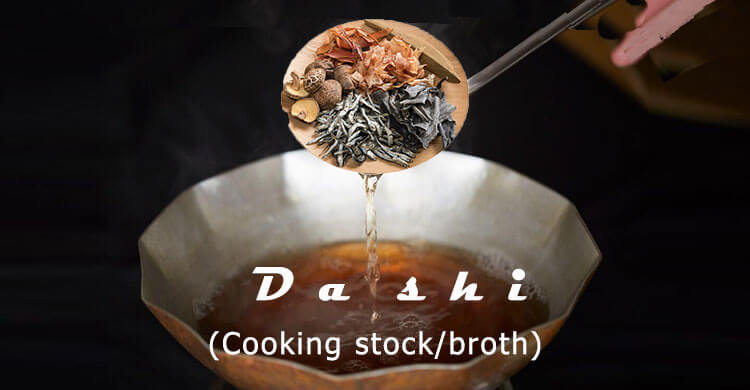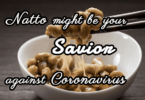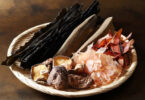Hi everone how are you doing? Today’s topic is “Cooking stock/broth” (Dashi) which is an indispensable item for Japanese cuisine.
Contents
What’s “Cooking stock/broth”(Dashi)?
Roughly speaking, Dashi used in Japanese cuisine is stock or broth and/or bouillon in French cooking but only one big difference is it doesn’t use meat at all in making.
Cooking stock/broth is a traditional Japanese seasoning which is mainly made from konbu (kelp, a kind of seawood), Katsuobushi (dried-bonito shavings), Niboshi (baby dried sardine), and Shiitake (mushroom).
It is a class of soup and cooking stock used in Japanese cuisine. Dashi forms the base for miso soup, clear broth, noodle broth, and many kinds of simmering liquid.
Cooking stock/broth is used in Asian cuisines to accentuate savory flavor as Umami(savouriness).
It is also mixed into flour base of some grilled foods like okonomiyaki((savory pancake with various ingredients) and takoyaki(octopus dumplings).
Standard fare, such as miso soup and soba, all these dishes use some type of dashi cooking stock.
So I’d like to talk about main 4 types as follows,
What’s “konbu-dashi” (kelp)?
One common dashi ingredient is a type of kelp called konbu-dashi. Over 90 per cent of domestic wild kombu comes from Hokkaido (northernmost prefecture).
Konbu can grow to five meters long or more. A special tool is used to twist the kelp growing on the seabed and hoist it out of the water.
The freshly harvested konbu is immediately dried in the sun. This concentrates one of the compounds responsible for umami (savouriness) in the konbu.
Simply soaked in water and heated, konbu releases its umami flavour components.
It’s important not to overdo the heating, otherwise bitterness will be imparted to the stock.
It was in the 18th century, after a new maritime route from northern Japan to Osaka was developed, that Hokkaido konbu became commercially available around the country.
There are still many shops in Osaka that specialize in konbu. People in the Kansai region tend to enjoy delicately flavoured dishes, so konbu-based dashi is very popular there.
What’s “Katsuobushi-dashi”(dried-bonito shavings)?
An equally common dashi ingredient is katsuobushi-dashi. It is made from bonito.
Fillets are first boiled and then smoked to reduce their moisture content. The fillets are then treated with mould because it helps to drive out moisture even more and also break down fats.
This method was developed about 200 years ago. After six months of curing, the fillets are a mere one-sixth of their original weight. Packed with umami, the katsuobushi is now ready for consumption.
Katsuobushi blocks are shaved into fine flakes. The larger the surface area of these shavings, the more effectively the flavour components will be released.
The flakes are placed in boiling water, and the heat is turned of immediately. After about one minute, the liquid is strained. To create dashi from bonito requires many steps and a great deal of time and care.
What’s Niboshi-dashi (baby dried sardines)
Niboshi-dashi is a simple dashi broth made with baby dried sardines or anchovies. It has a fishier flavor than other kinds of dashi and is more common in Japan’s eastern Kanto region, where there’s a greater preference for bold flavors.
To make niboshi-dashi, simply boil baby dried sardines or anchovies in water until the fragrant scent of the fish starts to emerge.
Some people prefer to remove the head and innards of the dried fish before boiling, believing that it makes the dashi bitter, while others prefer to boil the dried fish whole as it’s more natural and the fish heads provide a lot of flavor.
You can either strain the fish out or leave them in the broth for soup.
Shiitake-dashi (mushroom)?
Shiitake-dashi is another vegetarian and vegan-friendly dashi broth that’s made using dried shiitake mushrooms, due to their concentrated flavor.
Soak the dried shiitake mushrooms in lukewarm water, as water that is too hot can prevent the mushrooms from releasing their flavor compounds, which create the savory umami flavor.
The result is a thin, dark brown broth with a mushroom-like flavor. For a more flavorful broth, many people like to enhance their shiitake dashi by mixing one part shiitake dashi with two parts kombu dashi.
Incredibly simple and elegant, Japanese dashi can be made with just water and one or two basic ingredients such as kombu and dried bonito fish, a cousin of tuna.
It can be made in as little as 30 minutes compared to stock used in Western cooking, which may take hours to prepare.
Without dashi, it’s nearly impossible to cook a truly Japanese dish with authentic flavor.
Read on for our guide to the different varieties of dashi, how dashi is used, how it can be bought, for a true taste of Japanese cooking.
Since ancient times, the Japanese have been making great efforts to enrich their culinary culture, and the unique types of stock they’ve invented-collectively known as dashi are infused with their wisdom and ingenuity.
By the way, I wonder you have any particular seasoning in your country?
At the end, please enjoy a highly prestigious and expensive typical Japanese dish, Kaiseki ryori, in which you would surely have a taste of a simmered dish of pike conger and matsutake mushroom.
 Hamo fish (dagger-tooth pike conger) and matsutake mushroom soup, Japanese kaiseki traditional dinner
Hamo fish (dagger-tooth pike conger) and matsutake mushroom soup, Japanese kaiseki traditional dinner
Finally, “Umami (savory-taste)” and “Kaiseki ryori” to be well worth visiting, thanks















Leave a Comment